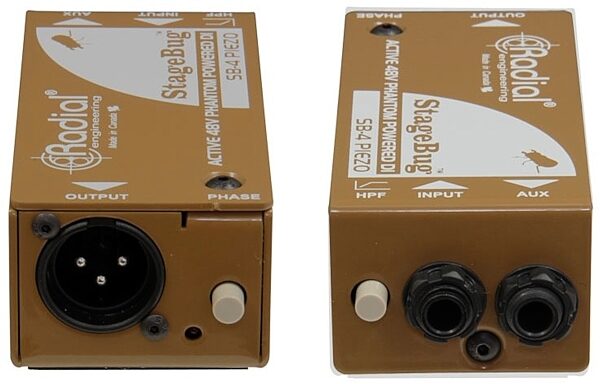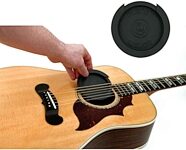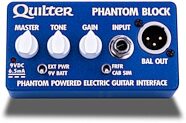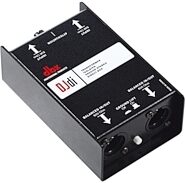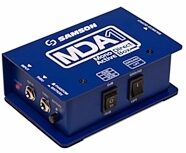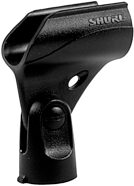Radial StageBug SB-4 Piezo Compact Active Piezo Pickup DI Direct Box
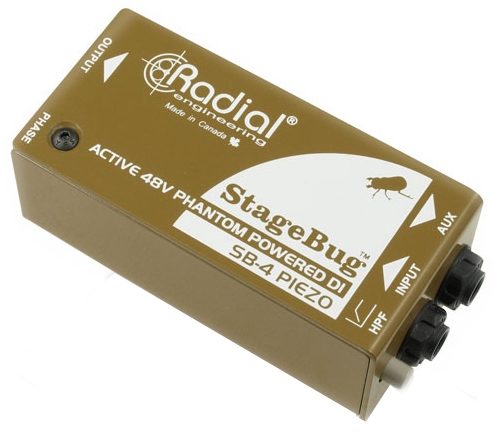

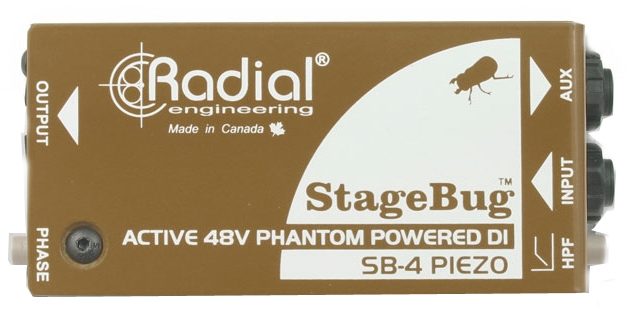
With its high 10 meg-ohm input impedance and wide frequency response, the SB-4 reduces the harsh bite that unbridled piezo pickups can produce with a DI box.
Overview
The Radial StageBug SB-4 is a compact active direct box that has been optimized for use with piezo transducers. This enables violin, dobro, mandolin, cello, upright bass and other instruments that are best amplified using a piezo to be connected without compromising the tone or frequency response.
The design begins with a 1/4" input for the instrument pickup. Unlike typical direct boxes that have a 1meg-ohm input impedance, the SB-4 features a very high 10meg-ohm impedance that smoothes out troublesome peaks that give piezos a bad name. The higher impedance also broadens the frequency response for a more natural and pleasing sound. The active circuit performs the high-to-low impedance conversion and balances the signal to enable long runs upwards to 100 meters without loss, delivering spectacular linearity and low distortion throughout the audio range.
To help eliminate feedback on stage, the SB-4 is equipped with a high-pass filter and 180* polarity reverse switch. The high pass filter eliminates excessive bottom end which in turn reduces resonance that can cause the top of the instrument to vibrate. The 180 polarity reverse helps reduce acoustic hot spots on stage by changing the phase relationship between the PA system and room acoustics which can combine at certain frequencies to create peaks. Reversing the polarity eliminates the acoustic peak without resorting to severe equalization which only serves to compromise the natural tone of the instrument. Connections include… read more an AUX out for a stage amplifier plus a standard XLR output to feed the PA. Power is derived from the console's 48V phantom, thus eliminating the need for batteries or external supply. One simply connects, turns on the phantom power and plays.
These features combined with the compact size make the StageBug SB-4 the perfect companion for orchestral artists, blue grass players and pop string quartets that need to turn it up when in concert.
Connect your piezo pickup directly to the StageBug SB-4 to get the best tone. No preamp is required! Activate the low-pass filter to eliminate resonance and you are set to go. The SB-4 balances the signal for long runs and smoothes out the peaks for a more natural sounding concert guitar!
Using the SB-4 on dobro
Use the SB-4 with a piezo on your resonator guitar to capture the unique sound of the body. Connect the AUX out to a stage amp if you like and then send the signal to the PA. The SB-4 will help eliminate the mid range squawk and frequency peaks that often force the sound engineer to turn you down in the mix.
Using the SB-4 on upright
Traveling with an upright is expensive! So reducing the size of the ancillary equipment is important. The super compact SB-4 connects from the piezo pickup to the PA and you do not need a preamp in between. The SB-4 delivers a deeper bass and more natural top end, greatly improving your tone through the PA.
Since the introduction of the Radial PZ-Pre, they have come to understand some of the challenges and discovered that the problem is not so much the transducer, but the interface between the transducer and the PA system. Piezo electric elements sound best when they are connected to a very high input impedance, but the higher the impedance, the more noise you get.
Think of it this way, as you increase the impedance (or resistance) of a buffer (or amplifier) less signal will pass through. With less signal, you have to increase the magnitude of the amplification to make up for it. As with all amplifiers, the quality differs greatly. Chip based amplifiers that are incredibly efficient tend to not sound very musical. Great sounding amplifiers such as a well designed class-A circuit sound great but are much more susceptible to noise. It is the careful balance between a class-A input buffer and the selective use of operational amplifiers (Op-Amps) that makes Radial products stand out. And this is why some of the world's most renowned artists use the PZ-Pre, PZ-Deluxe and PZ-DI for their piezo instruments.
The StageBug SB-4 Piezo is essentially a cut down version that enables the average musician to carry his own personal direct box to a gig and get the quality and performance that has made Radial the leader in instrument to pro-audio interfaces.
Making Connections
The StageBug SB-4 is a direct box designed specifically for piezo equipped instruments. These are commonly used on acoustic guitars, upright bass, violin and classical guitar. The intent with the SB-4 is to bypass any electronics (audio buffers) so that the piezo connects directly to the direct box and the signal is sent directly to a PA system via a microphone input channel.
Before making any connections, ensure all audio levels are turned down or equipment is turned off. This will help avoid plug-in transients that could damage more sensitive equipment such as tweeters.
The SB-4 Piezo is equipped with two 1/4" jacks and an XLR. The input jack is used to connect the instrument and the thru-put can be used to feed your on-stage amp or tuner. The XLR is used to connect to the PA system and for powering the SB-4's active circuit. Power comes from the mixer in the form of a 48V DC current known as phantom power. This handy invention enables the audio in the form of alternating current (AC) to be sent to the mixer at the same time as the 48V DC is sent from the mixer to the SB-4 using the same 3 conductor cable.
Once connected, slowly turn the levels up to a comfortable listening level. It is a good idea to test at low volumes as this helps prevent connection pops that can damage components should something not be quite right.
Using the high-pass filter
When amplifying an instrument through a PA system, low frequency resonant feedback is often encountered. This is usually due to low frequencies from the PA system that cause the instrument to vibrate. The high pass filter is essentially a bass-cut switch that reduces the low frequency output from the instrument. If you hear low frequency resonance, push it inward to activate. Reducing low frequencies also helps by removing excess mud, making it easier for the instrument to sit in the mix.
Using the 180* polarity reverse
Another similar source of feedback is resonance caused by the room acoustics and the PA system interaction. What happens is that certain bass frequencies can align with the echo causing what is known as a room mode. Modes can either amplify each other or cancel each other depending on the phase. By reversing the polarity, you can often eliminate resonant feedback. Simply depress to check for the best results in a given room.
Reducing ground noise
Some artists like to have a stage amp in addition to the PA and monitors. The StageBug SB-4 Piezo is equipped with a thru output that can be used for a stage amp or a tuner. When it is used with a stage amp, you can sometimes encounter hum and buzz caused by a ground loop. Ground loops occur when the audio ground and the electrical ground conflict. A side access ground lift switch will help eliminate the noise. Simply depress when needed.
Get an overview of the Radial StageBug SB4 Active Direct Box in this video demo:
- Smoothes out peaks, eliminates squawk
- High pass filter eliminates resonance
- Ultra compact to fit in your guitar case
read less
The design begins with a 1/4" input for the instrument pickup. Unlike typical direct boxes that have a 1meg-ohm input impedance, the SB-4 features a very high 10meg-ohm impedance that smoothes out troublesome peaks that give piezos a bad name. The higher impedance also broadens the frequency response for a more natural and pleasing sound. The active circuit performs the high-to-low impedance conversion and balances the signal to enable long runs upwards to 100 meters without loss, delivering spectacular linearity and low distortion throughout the audio range.
To help eliminate feedback on stage, the SB-4 is equipped with a high-pass filter and 180* polarity reverse switch. The high pass filter eliminates excessive bottom end which in turn reduces resonance that can cause the top of the instrument to vibrate. The 180 polarity reverse helps reduce acoustic hot spots on stage by changing the phase relationship between the PA system and room acoustics which can combine at certain frequencies to create peaks. Reversing the polarity eliminates the acoustic peak without resorting to severe equalization which only serves to compromise the natural tone of the instrument. Connections include… read more an AUX out for a stage amplifier plus a standard XLR output to feed the PA. Power is derived from the console's 48V phantom, thus eliminating the need for batteries or external supply. One simply connects, turns on the phantom power and plays.
These features combined with the compact size make the StageBug SB-4 the perfect companion for orchestral artists, blue grass players and pop string quartets that need to turn it up when in concert.
Applications
Using the SB-4 on classical guitarConnect your piezo pickup directly to the StageBug SB-4 to get the best tone. No preamp is required! Activate the low-pass filter to eliminate resonance and you are set to go. The SB-4 balances the signal for long runs and smoothes out the peaks for a more natural sounding concert guitar!
Using the SB-4 on dobro
Use the SB-4 with a piezo on your resonator guitar to capture the unique sound of the body. Connect the AUX out to a stage amp if you like and then send the signal to the PA. The SB-4 will help eliminate the mid range squawk and frequency peaks that often force the sound engineer to turn you down in the mix.
Using the SB-4 on upright
Traveling with an upright is expensive! So reducing the size of the ancillary equipment is important. The super compact SB-4 connects from the piezo pickup to the PA and you do not need a preamp in between. The SB-4 delivers a deeper bass and more natural top end, greatly improving your tone through the PA.
Development
As odd as it may sound, ever since the very first piezo transducers were introduced by Barcus-Berry in the 1960s, there have been concerns with respect to their performance. The primary concern has to do with the tone in that musicians and engineers constantly complain that the frequency response is peaky, dynamic response inconsistent and the instrument lacks natural warmth.Since the introduction of the Radial PZ-Pre, they have come to understand some of the challenges and discovered that the problem is not so much the transducer, but the interface between the transducer and the PA system. Piezo electric elements sound best when they are connected to a very high input impedance, but the higher the impedance, the more noise you get.
Think of it this way, as you increase the impedance (or resistance) of a buffer (or amplifier) less signal will pass through. With less signal, you have to increase the magnitude of the amplification to make up for it. As with all amplifiers, the quality differs greatly. Chip based amplifiers that are incredibly efficient tend to not sound very musical. Great sounding amplifiers such as a well designed class-A circuit sound great but are much more susceptible to noise. It is the careful balance between a class-A input buffer and the selective use of operational amplifiers (Op-Amps) that makes Radial products stand out. And this is why some of the world's most renowned artists use the PZ-Pre, PZ-Deluxe and PZ-DI for their piezo instruments.
The StageBug SB-4 Piezo is essentially a cut down version that enables the average musician to carry his own personal direct box to a gig and get the quality and performance that has made Radial the leader in instrument to pro-audio interfaces.
Using The StageBug SB-4
The following describes how to use the SB-4 Piezo with a standard PA system.Making Connections
The StageBug SB-4 is a direct box designed specifically for piezo equipped instruments. These are commonly used on acoustic guitars, upright bass, violin and classical guitar. The intent with the SB-4 is to bypass any electronics (audio buffers) so that the piezo connects directly to the direct box and the signal is sent directly to a PA system via a microphone input channel.
Before making any connections, ensure all audio levels are turned down or equipment is turned off. This will help avoid plug-in transients that could damage more sensitive equipment such as tweeters.
The SB-4 Piezo is equipped with two 1/4" jacks and an XLR. The input jack is used to connect the instrument and the thru-put can be used to feed your on-stage amp or tuner. The XLR is used to connect to the PA system and for powering the SB-4's active circuit. Power comes from the mixer in the form of a 48V DC current known as phantom power. This handy invention enables the audio in the form of alternating current (AC) to be sent to the mixer at the same time as the 48V DC is sent from the mixer to the SB-4 using the same 3 conductor cable.
Once connected, slowly turn the levels up to a comfortable listening level. It is a good idea to test at low volumes as this helps prevent connection pops that can damage components should something not be quite right.
Using the high-pass filter
When amplifying an instrument through a PA system, low frequency resonant feedback is often encountered. This is usually due to low frequencies from the PA system that cause the instrument to vibrate. The high pass filter is essentially a bass-cut switch that reduces the low frequency output from the instrument. If you hear low frequency resonance, push it inward to activate. Reducing low frequencies also helps by removing excess mud, making it easier for the instrument to sit in the mix.
Using the 180* polarity reverse
Another similar source of feedback is resonance caused by the room acoustics and the PA system interaction. What happens is that certain bass frequencies can align with the echo causing what is known as a room mode. Modes can either amplify each other or cancel each other depending on the phase. By reversing the polarity, you can often eliminate resonant feedback. Simply depress to check for the best results in a given room.
Reducing ground noise
Some artists like to have a stage amp in addition to the PA and monitors. The StageBug SB-4 Piezo is equipped with a thru output that can be used for a stage amp or a tuner. When it is used with a stage amp, you can sometimes encounter hum and buzz caused by a ground loop. Ground loops occur when the audio ground and the electrical ground conflict. A side access ground lift switch will help eliminate the noise. Simply depress when needed.
Get an overview of the Radial StageBug SB4 Active Direct Box in this video demo:
Features:
- Active DI optimized for piezo transducers- Smoothes out peaks, eliminates squawk
- High pass filter eliminates resonance
- Ultra compact to fit in your guitar case
WARNING: Cancer and Reproductive Harm - www.p65Warnings.ca.gov.
Specs
- Audio circuit type: Piezo optimized active buffer
- Frequency response: 20Hz to 20kHz
- Total harmonic distortion: <0.006%
- Dynamic range: 100dB
- Input impedance: 5Meg Ohms
- Maximum input: +4dBu
- Gain: +2dB
- Output impedance: 330R Ohms
- Equivalent input noise: -101dBu
- Noise floor: -97dBu
- Intermodulation distortion: <0.01%
- Phase deviation: 10* @ 50Hz
- Switches: High Pass Filter, Phase, Ground Lift
- Low-cut filter: 50 Hz
- Filter slope: 6dB/octave
- Instrument input: 1/4" buffered with piezo optimized load
- Auxilary output: 1/4" buffered to drive guitar effects, amplifier or tuner
- Balanced output: Pin-1 ground, pin-2 (+), pin-3 (-)
- Polarity reverse: 180*
- Ground lift: Soft lift with 100 Ohms to ground
- Construction: 16 gauge steel chassis & outer shell
- Finish: Baked enamel
- Size: (L x W x D) 4.5" x 1,85" x 1.35" (114mm x 47mm x 34mm)
- Weight: 0.55 lbs (250 grams)
- Shipping size: (L x W x D) 8.25" x 5" x 1.75" (210mm x 127mm x 44mm)
- Shipping weight: 0.8 lbs (365 grams)
- Power: 48V phantom power
- Conditions: For use in dry locations only between 5*C and 40*C
- Warranty: Radial 3-year, transferable
- Frequency response: 20Hz to 20kHz
- Total harmonic distortion: <0.006%
- Dynamic range: 100dB
- Input impedance: 5Meg Ohms
- Maximum input: +4dBu
- Gain: +2dB
- Output impedance: 330R Ohms
- Equivalent input noise: -101dBu
- Noise floor: -97dBu
- Intermodulation distortion: <0.01%
- Phase deviation: 10* @ 50Hz
- Switches: High Pass Filter, Phase, Ground Lift
- Low-cut filter: 50 Hz
- Filter slope: 6dB/octave
- Instrument input: 1/4" buffered with piezo optimized load
- Auxilary output: 1/4" buffered to drive guitar effects, amplifier or tuner
- Balanced output: Pin-1 ground, pin-2 (+), pin-3 (-)
- Polarity reverse: 180*
- Ground lift: Soft lift with 100 Ohms to ground
- Construction: 16 gauge steel chassis & outer shell
- Finish: Baked enamel
- Size: (L x W x D) 4.5" x 1,85" x 1.35" (114mm x 47mm x 34mm)
- Weight: 0.55 lbs (250 grams)
- Shipping size: (L x W x D) 8.25" x 5" x 1.75" (210mm x 127mm x 44mm)
- Shipping weight: 0.8 lbs (365 grams)
- Power: 48V phantom power
- Conditions: For use in dry locations only between 5*C and 40*C
- Warranty: Radial 3-year, transferable
- Dimensions and Weight in Packaging
- Base Item
- Shipping Weight: 0.75 lbs
- Shipping Dimensions: 5 x 3 x 2 in
- Manufacturer Part Number (MPN): R800 0140
New
$99.99
This is a carousel with product cards. Use the previous and next buttons to navigate.
People who bought this item also bought
This is a carousel with product cards. Use the previous and next buttons to navigate.

